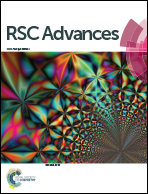Synthesis and characterization of self-cross-linkable and bactericidal methacrylate polymers having renewable cardanol moieties for surface coating applications†
Abstract
Polymers containing a renewable cardanol moiety were prepared via radical polymerization of 2-hydroxy-3-cardanylpropyl methacrylate (HCPM) and methyl methacrylate (MMA), where HCPM was synthesized by a reaction of cardanol with glycidyl methacrylate in the presence of a base catalyst. Incorporation of the cardanol moiety into PMMA was found to increase the thermal and mechanical stability of the brittle PMMA. When the cardanol based polymers were irradiated with UV light, the mechanical stability increased further because cross-linked networks were formed between the double bonds in the cardanol moieties. Cross-linked polymer films containing the cardanol moiety exhibited high gloss and transparency to visible light. Cardanol-containing polymers with and without the cross-linked networks and other cardanol-based polymers such as poly(cardanyl acrylate) and poly(2-acetoxy-3-cardanylpropyl methacrylate) all showed high antibacterial activity against Escherichia coli (E. coli), indicating that the disappearance of double bonds and/or the structure changes of connecting groups do not diminish the intrinsic bactericidal properties of the cardanol moieties.


 Please wait while we load your content...
Please wait while we load your content...